Overview
Type 2 diabetes is a chronic metabolic condition that many people face, characterized by insulin resistance and elevated blood sugar levels. This condition poses significant health risks, including heart disease and kidney damage. It's important to understand the symptoms, risk factors, and effective management strategies. In 2019, nearly 460 million people were affected worldwide, and projections indicate a rise to 853 million by 2050. This underscores the urgent need for education and support for those impacted.
Understanding that you are not alone in this journey is crucial. Many individuals share similar experiences, and together we can navigate the challenges of managing this condition. It's understandable to feel overwhelmed at times, but there are resources and communities ready to support you.
We encourage you to seek out information and connect with others who understand what you're going through. Remember, you are not alone, and we are here to support you every step of the way.
Introduction
Type 2 diabetes has become a global health crisis, impacting nearly 460 million people and accounting for approximately 96% of all diabetes cases. This chronic condition, characterized by insulin resistance and elevated blood sugar levels, brings with it significant health risks, including heart disease and kidney damage. Understanding the symptoms, risk factors, and management strategies is essential for those affected. Unfortunately, many individuals remain unaware of the complexities involved.
It's understandable to feel overwhelmed by this diagnosis. How can individuals navigate the challenges of this condition and empower themselves with the knowledge needed to manage their health effectively? You are not alone in this journey; together, we can explore the resources and support available to help you take control of your health.
Define Type 2 Diabetes and Its Impact
Condition 2 of diabetes is a long-lasting metabolic issue that many face, characterized by insulin resistance and increased blood sugar levels. Unlike the first form, where the body struggles to generate insulin, individuals with the second form can produce insulin but do not use it effectively. This dysfunction can lead to serious health complications, including heart disease, kidney damage, and neuropathy.
It's important to recognize that nearly 460 million individuals were affected by this condition worldwide in 2019, with classification 2 accounting for about 96% of all instances. The prevalence is particularly concerning among older adults, with rates exceeding 20% globally, and reaching as high as 24.4% for those aged 75 to 79. Factors such as obesity and a lack of physical activity significantly contribute to the rising occurrence of this condition. In fact, an elevated body mass index (BMI) accounts for more than 52% of the associated disability and mortality.
As our global population ages and lifestyles become increasingly sedentary, the number of adults living with diabetes is projected to rise to 853 million by 2050. It is essential to explain type 2 diabetes to understand the intricacies for effective management and prevention of its complications. You're not alone in this journey; we emphasize the necessity for thorough education and support for those impacted. Together, we can navigate this path and seek the resources needed for better health.
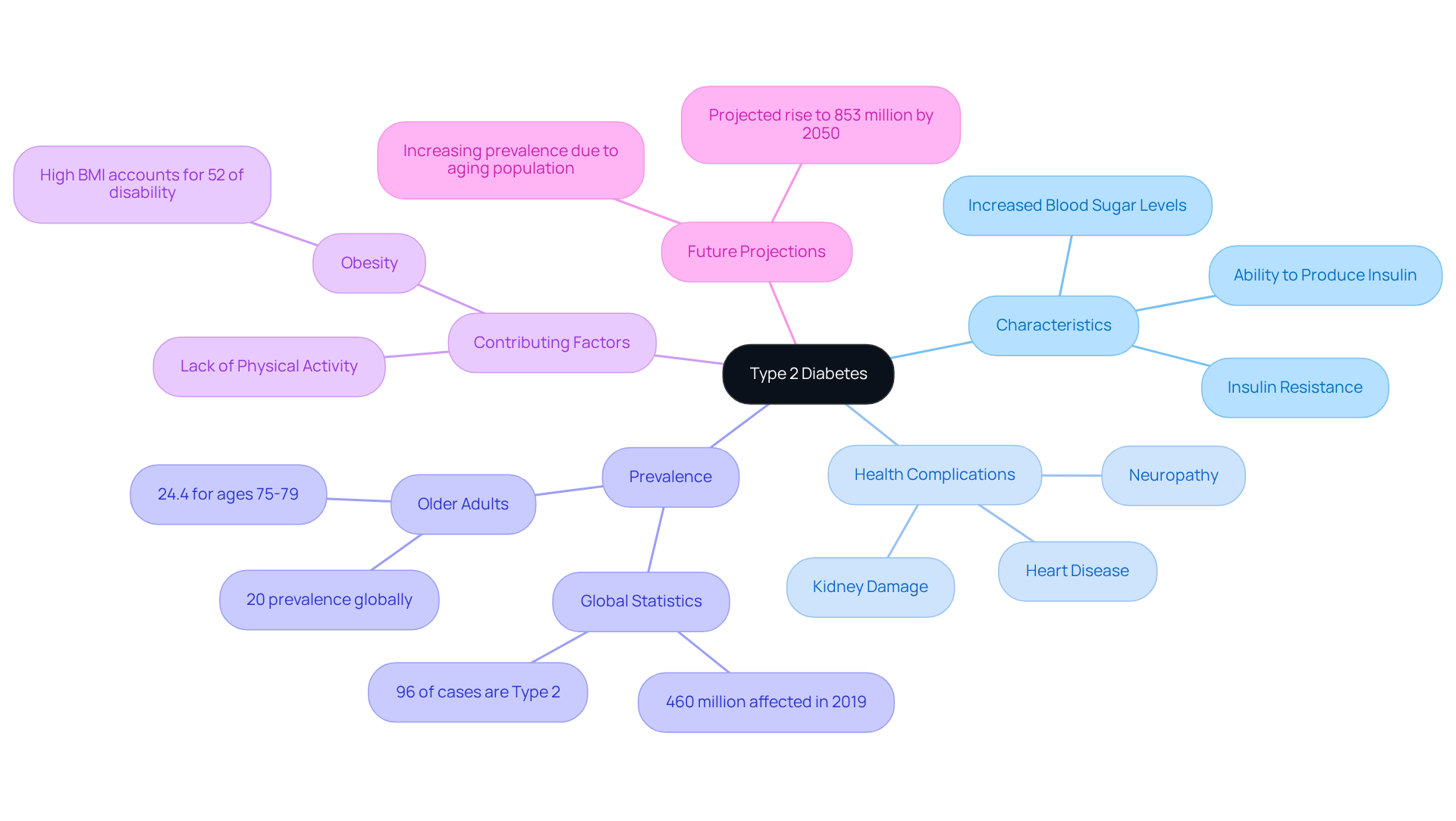
Identify Symptoms of Type 2 Diabetes
If you or someone you know has been diagnosed with Type 2 Diabetes, it’s important to explain type 2 diabetes and understand the common symptoms that may arise. Recognizing these signs can help you take proactive steps toward managing your health.
-
Increased thirst and frequent urination: When blood sugar levels rise, your kidneys work harder to filter and absorb the excess sugar. This can lead to increased urination and, consequently, heightened thirst. It’s understandable to feel concerned about these changes.
-
Extreme hunger: Even after eating, you might still feel hungry. This can be frustrating, as your body struggles to use glucose effectively. Remember, you’re not alone in experiencing this.
-
Fatigue: If you find yourself feeling unusually tired, it may be due to insufficient insulin action, leading to a lack of energy. It’s important to listen to your body and rest when needed.
-
Blurred vision: High blood sugar can pull fluid from the lenses of your eyes, making it difficult to focus. If you notice this symptom, it’s a good idea to consult with a healthcare professional.
-
Slow-healing sores or frequent infections: Diabetes can impair your body’s natural healing processes, making it essential to monitor any wounds or signs of infection closely.
-
Areas of darkened skin: You might notice patches of darkened skin, often in the armpits and neck, which can indicate insulin resistance.
Understanding these symptoms is a vital step to explain type 2 diabetes in your journey. If you’re experiencing any of them, please reach out for support. You're not alone in this journey, and there are resources available to help you manage your health effectively.
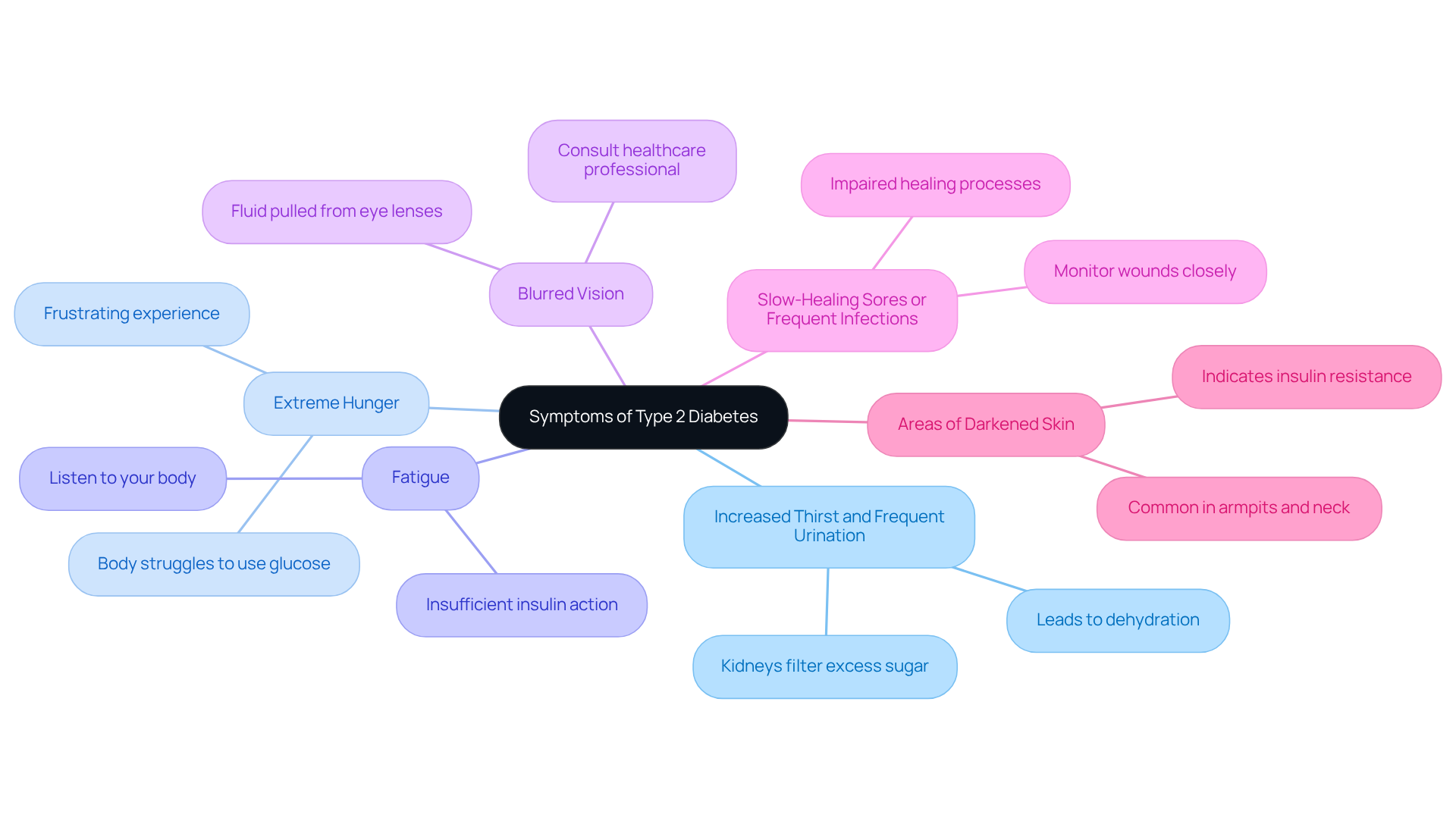
Recognize Risk Factors for Type 2 Diabetes
Understanding the risk factors to explain type 2 diabetes is essential for your health journey. Here are some key factors to consider:
-
Being overweight or obese: Excess body fat, especially around the abdomen, can significantly increase insulin resistance. It's important to explain type 2 diabetes, noting that around 90-95% of individuals diagnosed with this condition are affected by obesity, which has surged in recent years and is closely linked to rising blood sugar levels.
-
Age: As we age, particularly after 45, the risk of developing Type 2 Diabetes increases. In fact, more than 25% of adults aged 65 and older are impacted by this condition. Monitoring your health becomes increasingly important as you grow older.
-
Family background: If you have a family history of type 2 diabetes, this can help explain type 2 diabetes risk being elevated. For instance, if both parents have the condition, a child's risk can be as high as 50%. This highlights the importance of awareness in your family health history.
-
Physical inactivity: A sedentary lifestyle can lead to weight gain and worsen insulin resistance. By engaging in regular physical activity, you can significantly lower your risk of developing diabetes. Remember, every little bit counts!
-
Unhealthy diet: Diets high in processed foods and sugars are linked to obesity and, consequently, Type 2 Diabetes. Nutritionists often emphasize that even small dietary changes can lead to significant improvements in your health.
-
Ethnicity: Certain ethnic groups, such as African Americans, Hispanic Americans, and Native Americans, face a higher risk of developing Type 2 Diabetes. For example, non-Hispanic Black adults have a prevalence rate of 12.1%, while Hispanic adults have a rate of 11.7%. This awareness can be a crucial part of managing your health.
It is vital to explain type 2 diabetes by recognizing these risk factors for prevention and management. Community initiatives that promote healthy eating and physical activity can effectively reduce obesity rates and, in turn, lower the incidence of diabetes. By addressing obesity through lifestyle changes, you can significantly decrease your risk of developing this chronic condition. You're not alone in this journey, and there are resources available to support you every step of the way.
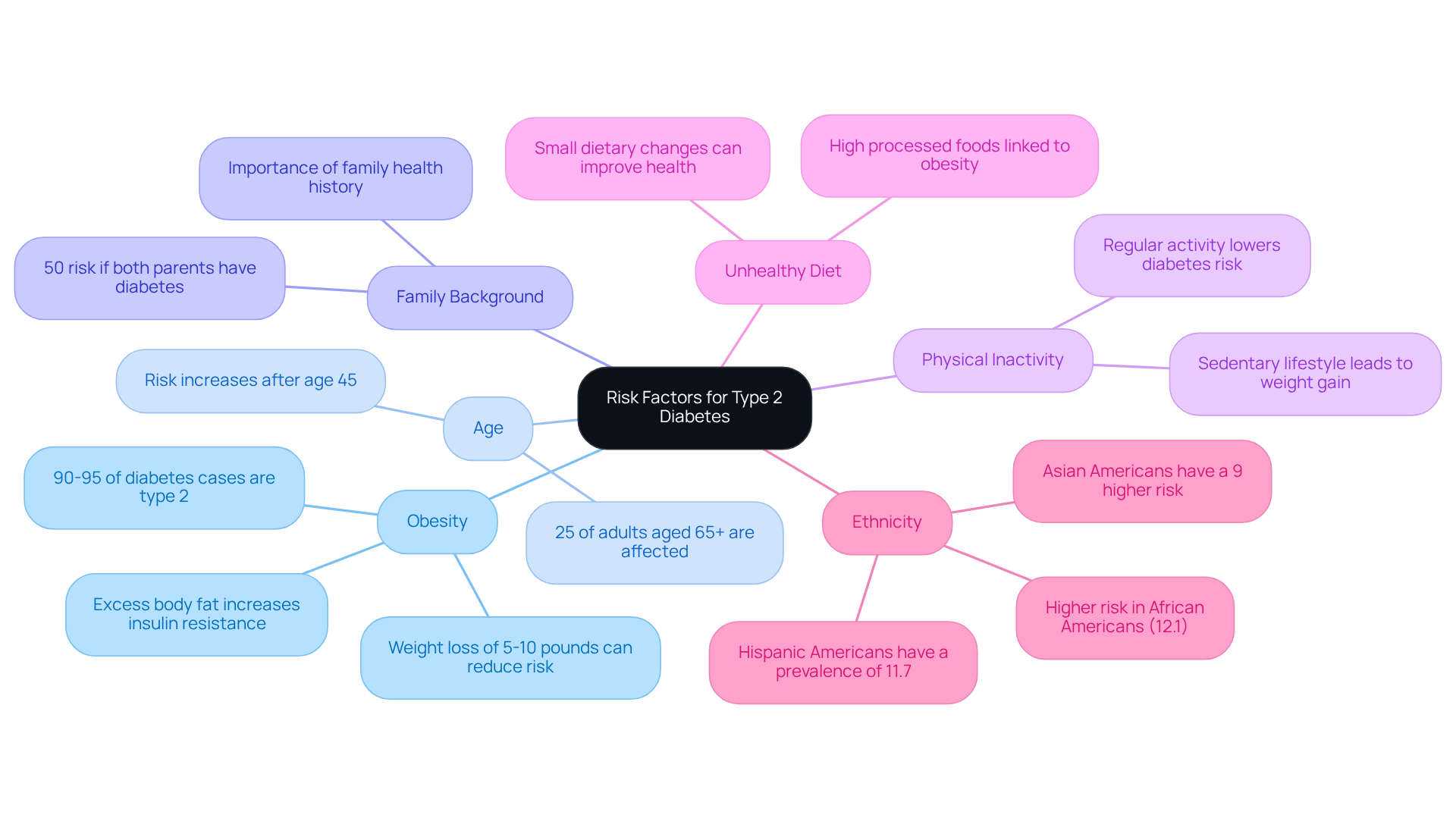
Understand the Diagnosis Process for Type 2 Diabetes
Understanding the diagnosis process is crucial for newly diagnosed patients to explain type 2 diabetes. At T2DSolutions, we aim to be a comprehensive resource hub for diabetes education and community support, providing valuable information on key tests that help healthcare providers assess blood sugar levels accurately:
- Fasting Plasma Glucose (FPG) Test: This test measures blood sugar after an overnight fast. A level of 126 mg/dL (7.0 mmol/L) or higher signifies elevated blood sugar. It's a widely used method due to its simplicity and reliability.
- Oral Glucose Tolerance Test (OGTT): This test assesses blood glucose levels before and after consuming a sweet beverage. A reading of 200 mg/dL (11.1 mmol/L) or higher two hours after ingestion verifies the condition. This test is particularly useful for identifying insulin resistance and prediabetes.
- Hemoglobin A1C Test: This test indicates average blood glucose levels over the past two to three months. An A1C of 6.5% or above indicates the presence of the condition. It is favored for its ability to provide a long-term view of blood sugar control.
- Random Plasma Glucose Test: A blood sample taken at any time can be used for this test. A level of 200 mg/dL (11.1 mmol/L) or higher suggests the condition, making it a convenient option for immediate assessment.
It's understandable to feel overwhelmed by the information. Current guidelines for diagnosing Type 2 Diabetes explain type 2 diabetes by emphasizing the importance of using these tests alongside clinical evaluation. The American Diabetes Association advises verifying any unusual outcomes with a repeat examination unless there are evident signs of the condition.
Recent advancements in diagnostic methods have enhanced the precision and availability of blood sugar testing. For instance, lowering the threshold for FPG to 104 mg/dL may enhance early detection, while the optimal cut-off for HbA1c is now suggested to be 6.03% for previously undiagnosed populations.
Real-world examples illustrate the effectiveness of these tests. In a study analyzing data from 117 population-based studies, it was found that the proportion of undiagnosed sugar-related illness detected varied significantly by region, highlighting the need for tailored screening strategies. Approximately 38% of the adult population in the U.S. has prediabetes, underscoring the importance of early detection and intervention.
Healthcare professionals emphasize the importance of early detection and intervention. As one specialist remarked, 'An early implementation of preventive measures for individuals at high risk can aid in lowering the occurrence of complications in those with the condition.' This highlights the essential function of precise testing in managing blood sugar levels effectively. Remember, you're not alone in this journey. For more information on managing diabetes and accessing educational resources, visit T2DSolutions.
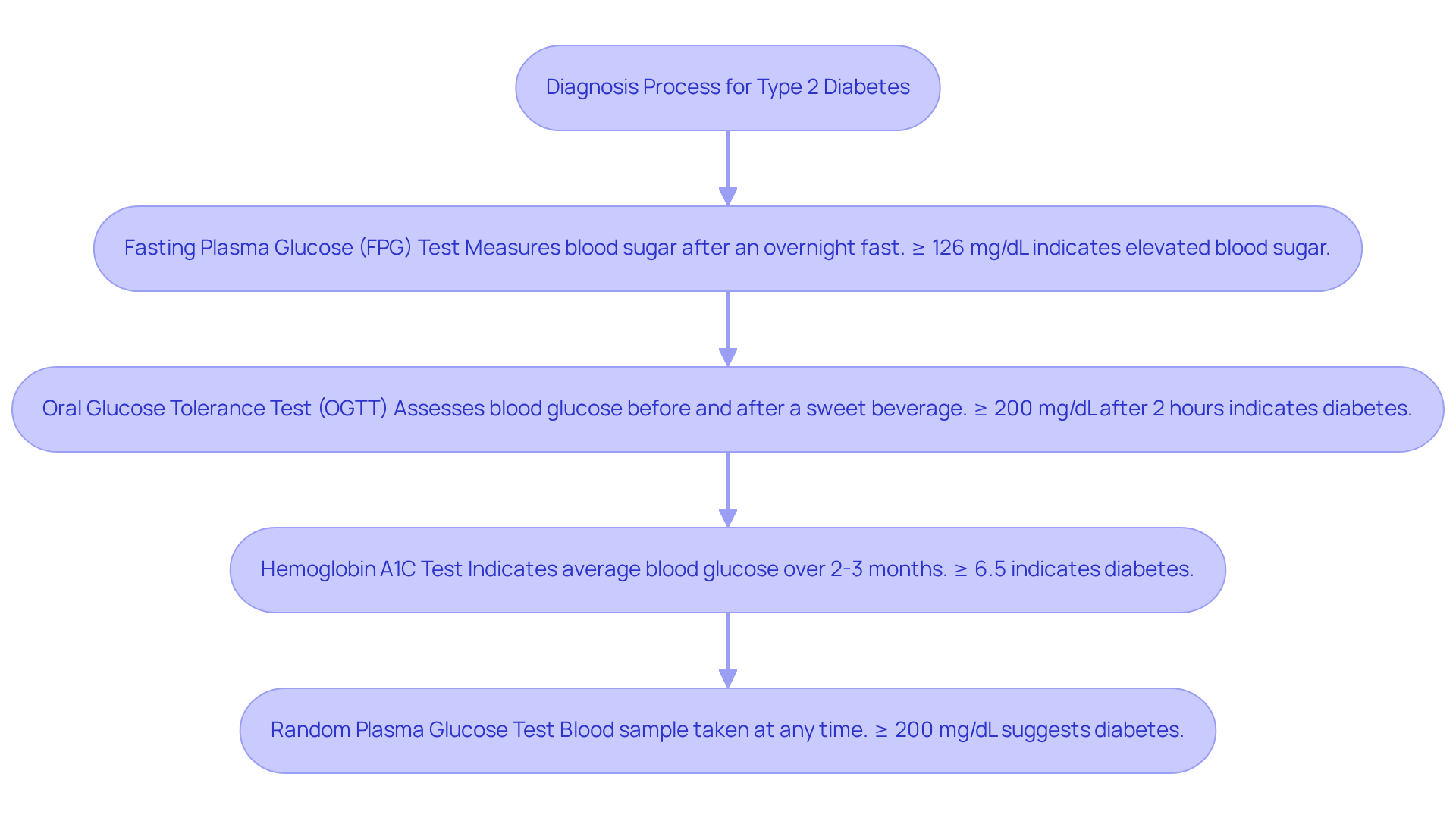
Implement Management Strategies for Type 2 Diabetes
Managing Type 2 Diabetes can feel overwhelming, but there are effective strategies to explain type 2 diabetes that can help you navigate this journey with confidence. Here are some key components to consider:
-
Healthy Eating: Emphasizing a balanced diet is crucial. Incorporate whole grains, a variety of fruits and vegetables, lean proteins, and healthy fats into your daily meals. It's understandable to feel confused about food choices, but dietitians recommend reducing processed foods and added sweeteners, as these can cause spikes in blood glucose levels. Many individuals who adopt a diet high in fiber and low in refined carbohydrates often experience improved blood glucose regulation. T2DSolutions offers resources and recipes to help you make healthier food choices.
-
Regular Physical Activity: Engaging in at least 150 minutes of moderate aerobic activity each week, such as brisk walking, cycling, or swimming, is essential. Combining aerobic exercises with strength training can further enhance insulin sensitivity and overall health. Remember, you're not alone in this; T2DSolutions encourages community engagement through local exercise groups and online challenges to motivate you.
-
Blood Sugar Monitoring: Regularly checking your blood sugar levels helps you understand how your diet, physical activity, and medications impact your glucose levels. This practice enables you to make timely adjustments to your management strategy, promoting a proactive approach to your care. T2DSolutions provides tools and tips for effective monitoring.
-
Medication Management: Adhering to your prescribed medication regimen is vital. This may include oral medications or insulin therapy, depending on your needs. Collaborating with your healthcare provider to modify medications as necessary can enhance your management of the condition. T2DSolutions offers guidance on medication adherence and management strategies.
-
Regular Check-ups: Scheduling consistent appointments with your healthcare provider ensures that your condition is monitored effectively. These check-ups allow for adjustments to treatment plans based on your progress and any emerging health concerns. T2DSolutions can assist in finding healthcare providers and scheduling appointments.
-
Emotional and Psychological Support: Acknowledging the emotional and psychological aspects of managing this condition is essential. It's common to experience stress or anxiety related to your diabetes, and seeking support from healthcare providers or community groups can be beneficial. T2DSolutions promotes community support through forums and support groups.
-
Community Engagement: Building a supportive community is crucial for those managing diabetes. Engaging with others who share similar experiences can foster resilience and provide encouragement. T2DSolutions serves as a hub for connecting individuals with local and online support networks.
By integrating these strategies into your daily life and utilizing the resources available through T2DSolutions, you can take significant steps to explain type 2 diabetes and effectively manage it, improving your overall health and quality of life. Remember, you are not alone in this journey; we are here to support you every step of the way.
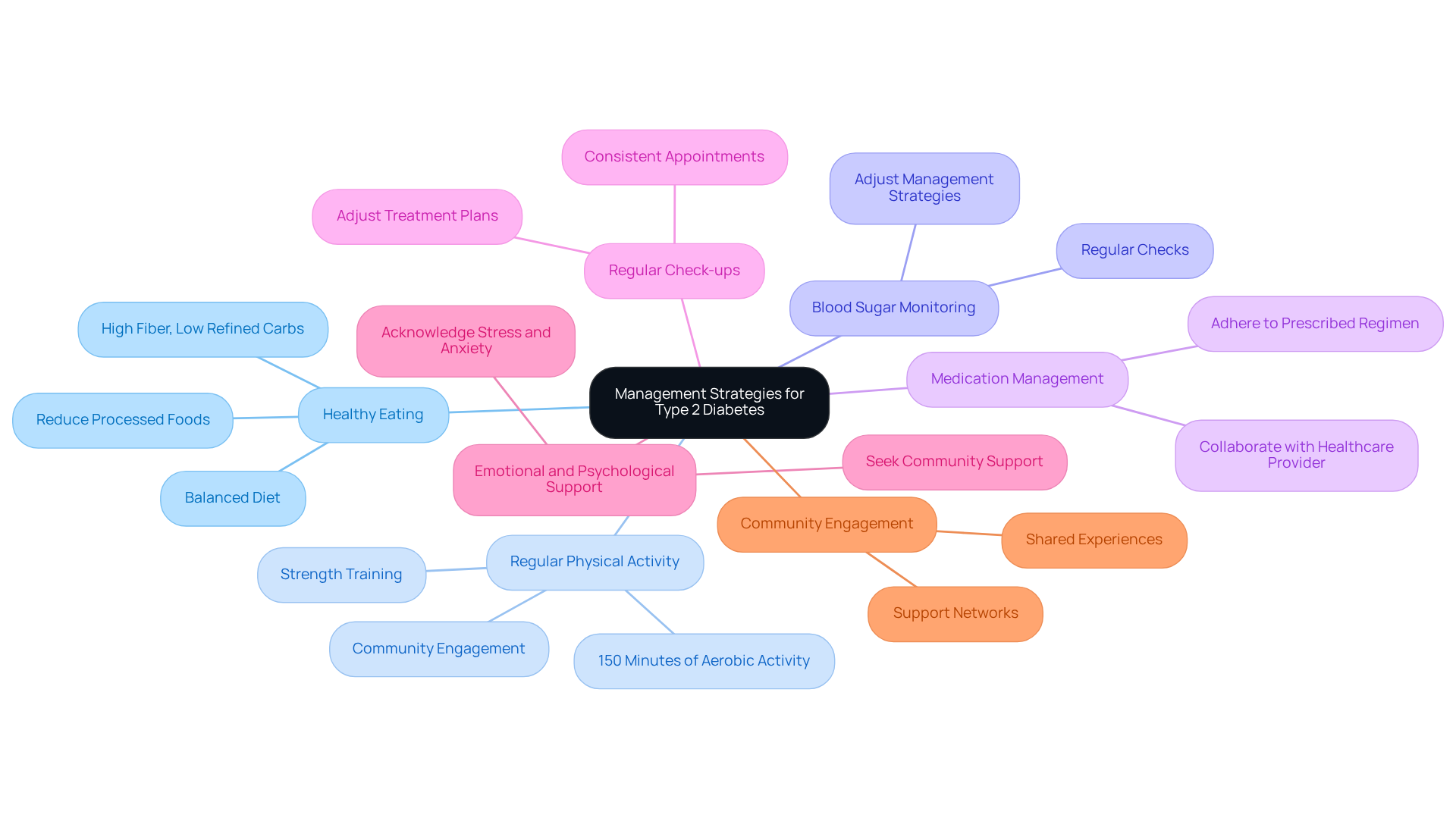
Conclusion
Understanding Type 2 Diabetes is crucial for effectively managing and preventing its complications. This chronic condition, characterized by insulin resistance and elevated blood sugar levels, affects millions globally and poses significant health risks. By educating yourself about the symptoms, risk factors, diagnosis process, and management strategies, you can take proactive steps toward improving your health and quality of life.
Key insights include recognizing symptoms such as:
- Increased thirst
- Fatigue
- Blurred vision
It's also important to understand risk factors like:
- Obesity
- Age
- Family history
The diagnosis process involves various tests that help healthcare professionals assess blood sugar levels accurately. Moreover, implementing management strategies—such as healthy eating, regular physical activity, and blood sugar monitoring—can empower you to control your condition effectively.
Taking charge of Type 2 Diabetes is not merely about managing symptoms; it’s about fostering a healthier lifestyle and building community support. Engaging with resources, seeking professional guidance, and connecting with others facing similar challenges can significantly enhance your journey toward better health. Remember, emphasizing education and support will not only help you manage this condition but also inspire a collective effort to combat the rising prevalence of Type 2 Diabetes. You're not alone in this journey, and we are here to support you every step of the way.
Frequently Asked Questions
What is Type 2 Diabetes?
Type 2 Diabetes is a long-lasting metabolic condition characterized by insulin resistance and increased blood sugar levels. Unlike Type 1 Diabetes, individuals with Type 2 can produce insulin but do not use it effectively, which can lead to serious health complications.
How prevalent is Type 2 Diabetes worldwide?
In 2019, nearly 460 million individuals were affected by Type 2 Diabetes globally, accounting for about 96% of all diabetes cases. The prevalence is particularly high among older adults, with rates exceeding 20% and reaching up to 24.4% for those aged 75 to 79.
What are the main risk factors for developing Type 2 Diabetes?
Key risk factors include obesity and a lack of physical activity. An elevated body mass index (BMI) contributes to over 52% of the associated disability and mortality linked to the condition.
What are the projected statistics for Type 2 Diabetes by 2050?
The number of adults living with Type 2 Diabetes is projected to rise to 853 million by 2050 due to an aging population and increasingly sedentary lifestyles.
What are the common symptoms of Type 2 Diabetes?
Common symptoms include increased thirst and frequent urination, extreme hunger, fatigue, blurred vision, slow-healing sores or frequent infections, and areas of darkened skin.
Why is it important to recognize the symptoms of Type 2 Diabetes?
Recognizing the symptoms is vital for proactive health management and can help individuals take necessary steps to manage their condition effectively.
What should someone do if they experience symptoms of Type 2 Diabetes?
If you experience symptoms such as increased thirst, extreme hunger, fatigue, blurred vision, slow-healing sores, or darkened skin patches, it is important to consult with a healthcare professional for support and management.



